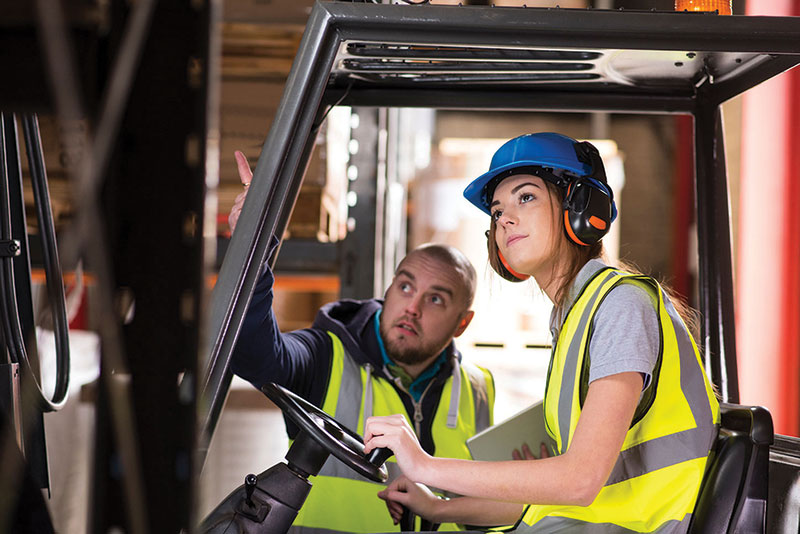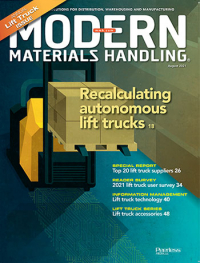Technology’s fit with training best practices
Telematics, VR and other technologies can help with safety and training, but don’t lessen the need for best practices like hands-on training, documenting training, clear procedures and continuous improvement.
Technology like telematics and virtual reality (VR) can help organizations improve lift truck operator training, but technology alone isn’t a substitute for a comprehensive approach to training that involves elements like hands-on practice with the equipment that will be used, documentation of training records, and clear safety-related procedures, according to Tony Parsons, corporate operating training manager for Wisconsin Lift Truck, a dealer organization that is part of Wolter.
“A good, written safety program is a great place, in that it lays out who is responsible for training and safety processes,” says Parsons. “One of the most common problems is a failure to remove an unsafe truck from operation. Trained operators know not to use a truck that is unsafe, but they may not be clear on what to do if they find one in an unsafe condition. Do they take the key and take it to their supervisor, or do they take it to maintenance? A written program can make these procedures clear to everyone involved.”
On the administrative end, it’s important to keep detailed records, adds Parsons. “You should be documenting details like who was in class and when, who was the instructor, and did the student pass,” he says.
A fairly common pitfall, Parsons says, is failure to train operators on every type of equipment they might use. An operator may spend most of his or her time on a reach truck, but if they also need to occasionally operate a pallet jack, then they should be trained on that equipment.
“Someone in maintenance, for example, should be trained to operate any equipment they might need to move or use as part of their work tasks, even if it’s just to move the equipment for service,” says Parsons. “They might not have to be an awesome operator if it’s a type of truck they don’t normally operate, but they should at least be competent in its operation and trained in the basics of how to use it.”
Technology has a place in improving operator training and safety, says Parsons. Telematics will record impact and near miss incidents, which will trigger the need to retrain to stay in compliance, says Parsons. VR training solutions, especially those that can simulate operator behaviors can complement hands-on training.
Train the trainers programs can help an organization by training an in-house person to conduct training, which can help speed up onboarding because a trainer resource is always on site. However, he adds, senior managers need to ensure the person conducting training for co-workers has adequate time and resources to help others learn.
In-person training for new operators should start with the basics of safe operation, such as how to drive and backup, how to lift, how to tilt the forks for stability during travel, and should eventually progress through to how the truck will get used in the particular warehouse environment or workflow. “If a lift truck operator is going to be in shipping or receiving, then they probably need training on how to drive on and off of trailer. If they are loading pallets onto racking, they should be trained on how to do that safely. The training should not stop until they are competent at each job they need to do.”
Thomas Lego, brand ambassador for Toyota Material Handling, agrees with the idea that technology such as telematics or VR, while valuable tools, aren’t by themselves a guarantee of an effective operator training program, or even of safe operations.
For example, telemetry can reliably record impacts to lift trucks, but it’s still up to the organization to examine that data and look for root causes, such as overly tight spaces or visual obstructions in areas with multiple incidents. Similarly, VR can help screen applicants or help operators brush up on skills, but doesn’t eliminate the need for hands-on training and testing.
“The further we progress in terms of technology, that technology should be supplementing what we already need to do well, and that is the requirement that says you must have some type of classroom training, and some type of hands-on training and verification, for each operator, at the prescribed times,” says Lego.
Companies with a strong training culture also look beyond the minimum level of compliance, and try to build operator training and coaching that contributes to safe, effective work processes in the actual DC environment.
“It’s important the operators understand not only how the equipment works in theory or in a confined [training] setting, but within a specific application,” Lego says. “They need to understand the nuances of how the equipment is going to be used, which gets back to the value of having resources available to help them on an ongoing basis.”

Article Topics
Lift Truck Tips News & Resources
Overlooked no more: The importance of lift truck inspections Lithium transition: It’s all about the outcomes Safety for automatic guided vehicle (AGV) environments Assessing the move to lithium Leasing’s fleet management upside Managing for lift truck operator safety Narrow aisle success: Think systems, then trucks More Lift Truck TipsLatest in Materials Handling
Geek+ and System Teknik deploy PopPick solution for pharmacy group Med24.dk Beckhoff USA opens new office in Austin, Texas Manhattan Associates selects TeamViewer as partner for warehouse vision picking ASME Foundation wins grant for technical workforce development The (Not So) Secret Weapons: How Key Cabinets and Asset Management Lockers Are Changing Supply Chain Operations MODEX C-Suite Interview with Harold Vanasse: The perfect blend of automation and sustainability Consultant and industry leader John M. Hill passes on at age 86 More Materials HandlingAbout the Author
Subscribe to Materials Handling Magazine

Find out what the world's most innovative companies are doing to improve productivity in their plants and distribution centers.
Start your FREE subscription today.
April 2024 Modern Materials Handling

Latest Resources












